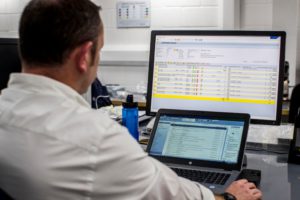For decades, Formula One has been dubbed the “fastest R&D lab on Earth”. The notion was that motor racing technology would sooner or later trickle down to the road car world. While that was certainly the case for some innovations and inventions, it was not necessarily true on a large scale. The challenges of Formula One were often too specific or the cost for industrial-scale production too high to introduce certain technologies in production vehicles. This, however, has changed in recent years, Mercedes explains.
Since the introduction of full hybrid powertrains, F1 technology has become more relevant for road cars than it has ever been before. But it is also true for other parts of the car – especially in the world of bits and bytes. Here is the fourth of five reasons, presented by Mercedes, why now, more than ever before, Formula One is at the forefront of technology – from road cars to consumer electronics, from medical technology to smart cities.
Digital engineering and testing
Formula One teams today are very data-driven organisations. The 500 Gigabytes or so that are produced at the track over the course or a race weekend are just the tip of the iceberg. At the factory, Mercedes-AMG Petronas Motorsport produces about five to ten Terabytes of data – every week! Over the course of the year, the amount of data extends to over 350 Terabytes. Virtually every department in the factory produces data, many of them in large amounts. Whether it’s Computational Fluid Dynamics (CFD), Computer-aided design (CAD), wind tunnels or test rigs – all of those technologies and test methods are data-heavy.
But let’s put the annual 350 Terabytes in context. A Mercedes preview release is about 150 Kilobytes in size as a pdf attachment. Our annual data volume amounts to something along the lines of two billion preview pdfs…
Now imagine having to skim through two billion Mercedes preview features, trying to find that one piece of crucial information that you are looking for
Not exactly an easy task – and probably not a whole lot of fun either. Which is why F1 teams invest heavily in areas like data analysis, data science, machine learning and artificial intelligence. The same kind of technologies that become ever more important in many other data-driven industries as well.
The team will, for example, use computational raw data analysis to try and spot patterns that indicate trends or failures of car components. With increasing computer speeds, people can analyse more and more data. Even complex data – for example, images of tyre wear – can today go through automatic pre-analysis.

How is this relevant for the outside world?
Because many other areas use similar technologies. Whether you’re trying to determine if a Formula One power unit is about to fail or a road car needs a service soon – the solutions are very similar. Both challenges rely on automated data analysis which triggers a reaction – whether that’s a radio call to an F1 driver that he has to park the car or booking an appointment with your local repair shop in good time. And the similarities extend far beyond the automotive industry. Even human health data can be analysed in a similar way. While the problems are different, the tool sets are the same.
That’s the reason why the F1 team in the UK has a number of joint projects with the Daimler R&D groups in Germany. It started as a specific collaboration on suspension modelling between the Brackley vehicle dynamics group and the ride and handling group in Sindelfingen. The suspension requirements for a road car and a race car are very different. Despite that, both groups benefited from the project. The cooperation has since grown to include many areas of common interest. Although the applications are quite different between road car and race car, the developing tools sets have much in common. The other area in common is that both the F1 engineers and the road car engineers work increasingly in the virtual world. That is using digital design, development and testing tools, as such their challenges and the tools needed to reach solutions can be mutually beneficial.































